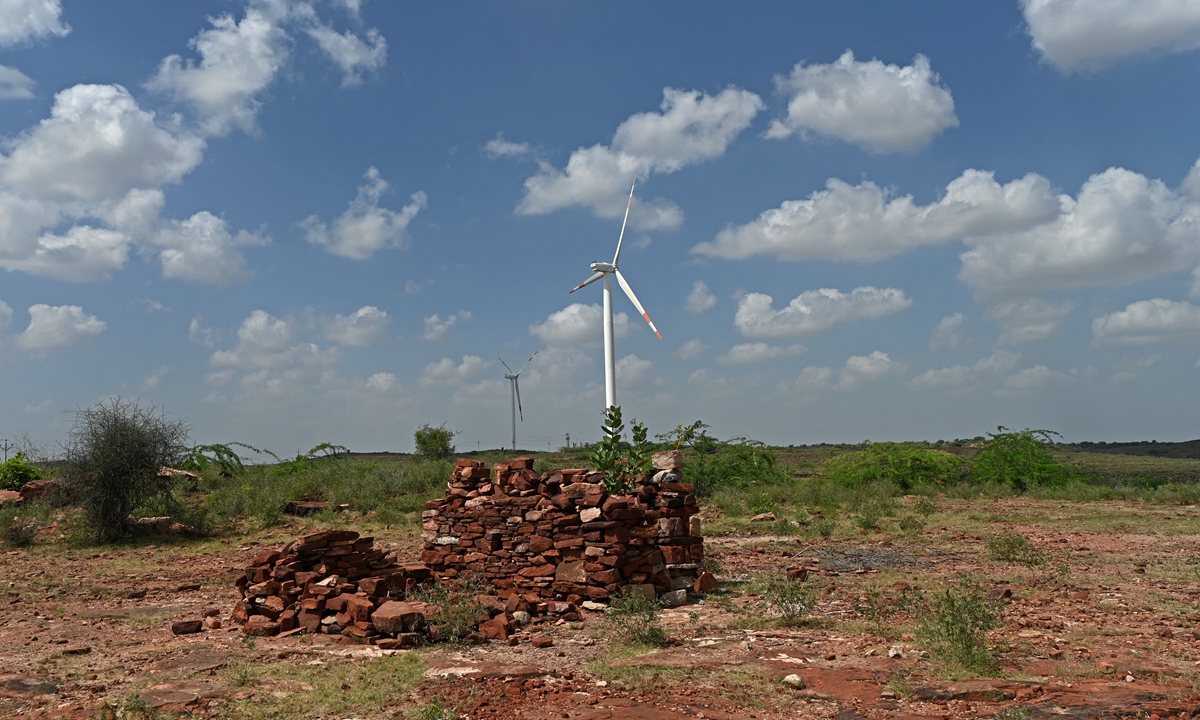Environmental dilemma
Global News 2022-02-20 10:42:124109673Malaysia United TimesNewsCenter

A windmill farm is pictured at Osian in Jodhpur district of India's Rajasthan state on October 6, 2021. Photo: AFP
A conservationist wants India's government to bury renewable power lines to protect rare birds. Protesting villagers halt a wind energy project to save their local forest. And farmers stop a solar plant from eating up pastureland.As India forges ahead with ambitious plans to boost its clean energy supply, the government is facing push-back that highlights the challenges of balancing the competing goals of going green with protecting wildlife and forests.
While government authorities argue that shifting India away from planet-warming fossil fuels is a top priority, environmentalists and communities say nature is being treated as collateral damage in the national rush to roll out green power.
"We aren't against renewable energy," said conservationist M K Ranjitsinh, who petitioned the Supreme Court to order the Ministry of Power to bury electricity lines that threaten large birds in the Thar Desert in the northwestern states of Rajasthan and Gujarat.
"We only say it shouldn't come at the cost of the extinction of bird species," he told the Thomson Reuters Foundation.
Ranjitsinh's petition, filed in April 2021, was based on reports by the government's Wildlife Institute of India (WII) showing birds were being killed by solar and wind power lines in Thar, due to collision or electrocution.
A 2018 report said WII researchers who surveyed 80 kilometers of overhead power lines over a year found nearly 300 carcasses of about 40 species, including the Great Indian Bustard, one of the world's largest birds, and the Lesser Florican.
Both are listed as critically endangered by the International Union for Conservation of Nature, with the WII noting there are only about 150 bustards left in India, mainly in Rajasthan and Gujarat.
"There are several threats that are inching the bustard closer to extinction - however, power lines seem to be the most significant," the report said.
The Supreme Court ruled that any future power lines running through existing or potential habitats of both species must be installed below ground.
In addition, if a court-appointed committee decides it is feasible, more than 300 kilometers of lines will have to be moved underground and another 1,300 kilometers fitted with diverters, brightly colored or reflective devices to help birds see and avoid them.
Several ministries launched an appeal in December, saying the cost of dismantling and burying the lines would set back progress on a national goal of cutting carbon emissions to net zero by 2070.
Subrahmanyam Pulipaka, CEO of the National Solar Energy Federation of India, whose members include companies fitting power lines in Thar, said burying high-voltage lines would be a "huge task," costing 10 times more than overhead lines.
'No land is waste'
In 2021, Prime Minister Narendra Modi promised India would meet 50 percent of its power needs with renewables by 2030, by boosting solar, wind and other clean energy capacity to 500 gigawatts.
Currently, renewables make up just over a quarter of the national electricity supply, and demand is rising fast.
The International Energy Agency said in a 2021 report that India's power needs were projected to jump 35 percent between 2019 and 2030 as its economy develops.
Debajit Palit, director of the rural energy program at The Energy and Resources Institute, based in New Delhi, said finding enough space is one of the biggest challenges facing the fast-growing renewable energy sector.
The government says it mainly uses "wasteland" for renewables infrastructure and issues an atlas showing areas available for such projects. The latest edition, in 2019, identified nearly 17 percent of the country as "wasteland."
But Palit said that, in reality, "no land is waste and may have some value in terms of local biodiversity or grazing of cattle and other activities."
That was the case for residents of Sangnara village in Gujarat, who in August 2021 protested to save a nearby forest the government had leased to four companies for a planned wind farm with 40 turbines.
After watching six turbines go up, the villagers, whose families have protected the forest for 500 years, filed a petition with India's main environment court, the National Green Tribunal, to have the work stopped.
The project, which also included building new roads, would cut down more than 20,000 trees, decimating pastureland and exacerbating the deforestation that is a major driver of climate change, the villagers said.
Farmer Shankarbhai Limbani said there was no dispute over the ownership of the land, which belongs to the government.
"But it is a natural resource for us which not only provides us with a good environment but livelihoods as well because our cattle feed on it... It is good to have [renewable] electricity, but we can't even think of losing our forest for it," he said.
Jeetendra Nalawade, spokesperson for the Suzlon Group, one of the companies behind the project, declined to comment while the case was still with the court.
"We are complying with the directions of the Honourable National Green Tribunal in the matter," he said by email.
The other three firms involved did not respond to requests for comment.
In a similar case in September 2021, the Rajasthan high court sided with residents of Gajner village and ordered authorities to stop building a transmission tower and roads to a nearby solar power plant.
The villagers had held a 220-day protest against the project, which would have used 124 hectares of government-owned pastureland.
Village head Geeta Kumhar, who led the protests, said residents supported the growth of green energy but did not want to sacrifice their pastureland for it.
Local district collector Namit Mehta said the process of dismantling the tower and roads had already begun.
Impact assessments
To avoid such clashes over the rollout of renewables, some experts say India should focus on smaller clean energy projects.
"When you go for large plants, there will be land and environmental issues.
That is why rooftop solar or distributed generation makes more sense," said Rangan Banerjee, energy expert at the Indian Institute of Technology Bombay.
For Abi Tamim Vanak, associate professor at the Ashoka Trust for Research in Ecology and the Environment, the answer is to subject clean energy infrastructure to the same environmental impact assessments as other major building projects.
To speed up adoption of renewables, India's government in 2006 exempted green energy developers from having to measure the potential environmental and social impacts of a planned project.
As conservationists and communities continue their efforts to protect the nature around them from India's green dreams, the irony is not lost on Gajner's village head Kumhar.
"How unjustifiable is it that the government is destroying our environment - besides denying grazing land to our livestock - and saying we are doing it for climate change?" she asked.
Reuters
Previous:11 people killed in Philippine truck crash
Next: S.Korea presidential candidates kick off ‘tightest’ race
Next: S.Korea presidential candidates kick off ‘tightest’ race
Related Reading
- ‘Three Evil Forces’ continue to lurk in shadows of riots, color revolutions in Central Asia: experts
- Singapore Airshow expects sharp fall in visitors
- Tabuk mayor tests positive for COVID-19
- DILG: No vax exemption cards
- Makati to provide free swab tests
- ‘What can we do?’: Millions in African countries need power
- Three dead in blast on Indian warship
- Man drowns in Muar river while testing boat
- Australia COVID-19 infections hit record amid runaway Omicron outbreak
- American troops in Japan stay on-base for two weeks after virus spread
